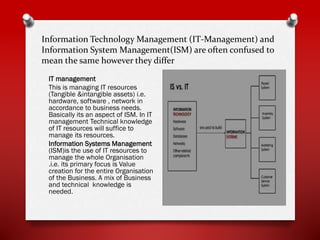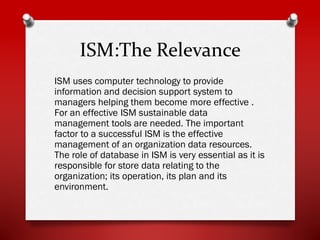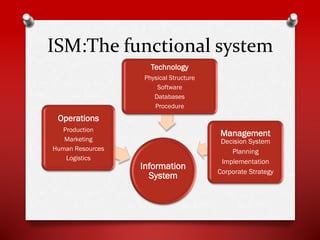Information system management the new version
- 1. Introduction Information system is the combination of hardware, software, infrastructure and trained personnel organized to facilitate planning control co ordination and decision making in an organisation . This system collects, stores processes, accesses and delivers information, knowledge and digital products.
- 3. Information system management Is the application of information technology to support major functions in any organization. It supports process of collection, manipulation, storage, distribution and utilization of an organization's information resources. Digital business rely on information systems to carry out and manage operations ,interact with customers and suppliers and also give a competitive edge.
- 4. Information Technology Management (IT-Management) and Information System Management(ISM) are often confused to mean the same however they differ IT management This is managing IT resources (Tangible &intangible assets) i.e. hardware, software , network in accordance to business needs. Basically its an aspect of ISM. In IT management Technical knowledge of IT resources will suffice to manage its resources. Information Systems Management (ISM)is the use of IT resources to manage the whole Organisation .i.e. its primary focus is Value creation for the entire Organisation of the Business. A mix of Business and technical knowledge is needed.
- 5. ISM: The Influence Effective management Business understanding Communication Delivery Systemization of business Business Direction Management Efficiency Reduced Manpower
- 6. ISM: Functions Data Collection: ISM with the use of IT resources is used to collect all forms of data both from internal and external sources . Data Processing: The data collected as stated above is sorted and converted into useful information for decision making. Storing Information: Information gathered will be stored In database or warehoused for Retrieval. Retrieval of Information: Data collected and Processed and stored information will be used for business analysis and management purposes when needed
- 7. ISM:The Relevance ISM uses computer technology to provide information and decision support system to managers helping them become more effective . For an effective ISM sustainable data management tools are needed. The important factor to a successful ISM is the effective management of an organization data resources. The role of database in ISM is very essential as it is responsible for store data relating to the organization; its operation, its plan and its environment.
- 8. ISM:The functional system Technology Physical Structure Software Databases Procedure Operations Production Marketing Human Resources Logistics Management Information System Decision System Planning Implementation Corporate Strategy
- 9. ISM: The System Structure. Production System: Under this system , transaction processing, operation control, managerial control and strategic planning Marketing System : Planning, promotions, sales, product development, market research Human Resource System: Recruitment , training and education, development of employees, record and evaluation of employees, compensation Logistics System: Purchasing, receiving, inventory control, distribution Physical Structure System Hardware, software, data base , procedures and personnel
- 10. Applications of ISM supports strategy, data processing and management goals. Below are examples of the functions of ISM in different systems Applications in Marketing Applications in finance O Order processing • General ledger O Sales management • Cash management O Logistic management • Budget planning O Consumer research O Sales for casting • Financial modelling
- 11. An expert speaks Maria Griffith is a very experienced information systems lecturer at The University Of Salford. The video consists of her explaining the concepts of information systems management











